Donna Smallin Kuper's Blog: The One-Minute Organizer Blog, page 15
October 3, 2014
Unclutter Your Home: 7 Simple Steps, 700 Tips & Ideas
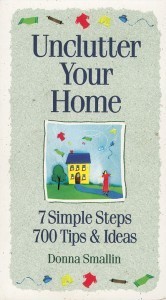 Way back in 1999, I wrote a book that launched my career as an organizing and cleaning expert. It sold more than 100,000 copies and was translated into a dozen languages.
Way back in 1999, I wrote a book that launched my career as an organizing and cleaning expert. It sold more than 100,000 copies and was translated into a dozen languages.
I’ve written many books since then, but my first book was…well, it was my first baby. So it is with a momma’s great pride that I have a special announcement to make.
For the first time ever, Unclutter Your Home: 7 Simple Steps, 700 Tips & Ideas is now available in ebook form. And it’s been completely updated and revised to include many of my newest tips and ideas.
Before I forget, I need to tell you that all of the links in this post direct you to Amazon.com where you can download the Kindle version. But my publisher is partnered with 35 ebook retailers, which means that you can download the ebook version through Barnes & Noble, Apple, Google, Kobo, and Scribd as well as Amazon. You’ll also find it in libraries.
Updating this book was a blast – as in blast from the past!
When my publisher sent the original manuscript to me this summer and I read through the pages, I was amazed by how many things had changed in 15 years. Back then, we were developing photographs rather taking and storing them as digital images. Email and Internet use was still relatively new. We didn’t have the conveniences of online banking and bill paying. And apps were a thing of the future.
But clutter was still clutter and the advice I gave back then to unclutter your home is the same advice I give today. It all starts with figuring out what’s important to you right now, at this point in your life, and letting go of the rest.
So what are the “7 Simple Steps” promised in the title of this book?
Step 1: Assess Your Situation. It helps to understand how and why clutter happens and how it affects the quality of your life.
Step 2: Plan for Success. Recognize your role as clutterer and declutterer. Find your motivation, commit to your goal, and get started.
Step 3. Lighten Your Load. Let go of the things you no longer love or use.
Step 4. Contain Yourself. Find a place for everything so you can always put things in their place.
Step 5. Revamp Clutter Zones. Minimize clutter by organizing your possessions to fit your home and lifestyle.
Step 6. Simplify with Systems. Simplify your life with systems for handling routine chores and tasks.
Step 7. Ban Clutter Forever. Create an environment that does not invite or welcome clutter into your home.
Here’s what one reviewer had to say about the original version of Unclutter Your Home: 7 Simple Steps, 700 Tips & Ideas
This is a really useful book. There are hundreds of quick tips on all aspects of homemaking. The book is extremely easy to read and the tips offered are practical and easy to implement.
And another reviewer wrote this after reading it:
I do have to say that reading this book inspired me to do some *SERIOUS* uncluttering. I’ve only owned it a month and in that time I think I’ve thrown out, sold, or donated about two dumpsters worth of things I was holding onto for all the wrong reasons. For the first time I’m enjoying getting rid of things, and making room to actually have places to put things away.
Read a sample of my book for free – and take my clutter quiz!
To read a sample of my book, click on this link to Unclutter Your Home: 7 Simple Steps, 700 Tips & Ideas. Then click on “Look Inside” up near the book cover image to take a look at the Table of Contents and read through the first dozen or so pages.
Oh, and be sure to take the quick “What’s Your Clutter Quotient?” quiz that you’ll find in Chapter 1, okay? What was your score? Were you surprised by the results or no?
The post Unclutter Your Home: 7 Simple Steps, 700 Tips & Ideas appeared first on Declutter Your Life with Donna Smallin Kuper.
September 24, 2014
Got ADHD? Get Organized.
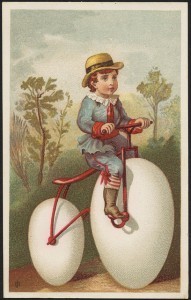
photo credit: Boston Public Library via photopin cc
In 1845, Dr. Heinrich Hoffmann published a story called “The Story of Fidgety Philip” about a young boy who had trouble sitting still and paying attention. He would likely be diagnosed today as having attention-deficit hyperactivity disorder (ADHD).
Previously called attention-deficit disorder (ADD), ADHD is a condition marked by inattentiveness, distractability, lateness, and disorganization. If you can relate to these challenges, there’s a chance you may have had ADHD throughout your life and were never diagnosed.
The National Institute of Mental Health estimates 3% to 5% of kids have ADHD, but some experts believe that figure could be as high as 10%. Approximately the same percentage of adults are diagnosed with ADHD.
Symptoms of ADHD include poor sense of time, trouble starting on a project or finishing one, impulsivity, and general disorganization. These challenges are related to executive function in the frontal section of the brain. There is a strong genetic component to ADHD and many parents don’t know that they have ADHD until after their children have been diagnosed with it.
Getting organized makes life a lot easier for everyone. But for those with ADHD, organization can be elusive. Following are a few basic organization tips that can help anyone, but are especially useful for people with ADHD.
Time Management
Having a planner is the first step. Choose paper or digital based on your personality and needs.
Use reminders on your smartphone to help you transition between projects, meetings, and errands.
Make lists of things to do using an app like Evernote or jot your “to-dos” in a spiral notebook.
Prioritize each day. Determine the three Most Important Tasks (MITs) from your list to accomplish today.
Use a timer. Set a timer for 15 minutes to get started on a task. To accomplish a large project, set a timer for three 15-minute consecutive periods with five-minute breaks between working periods.
Paper Management
Use online resources and archives to eliminate paper, such as setting up online bill pay, accounts for insurance Explanation of Benefits (EOBs), and other financial paperwork.
Plan on spending five minutes of paper triage daily and two hours of administrative time weekly.
During paper triage, separate papers that require you to do something like bills to pay, a new insurance policy to file, or credit card statements to review. Trash, recycle, or shred as much as you can.
During administrative time, pay bills, review action items, add to your to-do list, file and review important papers.
Be creative about filing options. You can use magazine sorters, decorative boxes, or notebooks to keep paper organized rather than filing everything in hanging folders in a drawer (although that works too).
Think about scanning as an option. You can store documents on your computer or hard drive and retrieve them easily with a search function.
Home Organization
Work in baby steps. Start with a small project, work on it in 15-minute increments until you are done, and enjoy the results of your efforts!
Find a clutter buddy. Having the support of an additional person in your space or on the phone can help you make decisions, commit to the work of organization, and be accountable to your goals.
Create deadlines for your home organization. There’s nothing like company coming, a holiday event or grandkids spending the night that makes you focus, declutter and get organized.
You can learn more about ADHD and find resources at www.additudemag.com and www.chadd.org.
 Ellen Delap is a Certified Professional Organizer and Certified Family Manager Coach. For more than 10 years, she’s been helping her clients make time and space for what’s important to them by organizing their homes, offices and their daily living. Ellen works one on one with her clients in their homes and offices to streamline their environment, creating effective strategies for an organized lifestyle and prioritizing organization in their daily routine. She specializes in working with ADD and ADHD families, adults and students. Learn more about Ellen and her business at www.professional-organizer.com, @TexasOrganizer on Twitter, Ellen Delap Professional Organizer on Facebook, and Ellen Delap on Pinterest.
Ellen Delap is a Certified Professional Organizer and Certified Family Manager Coach. For more than 10 years, she’s been helping her clients make time and space for what’s important to them by organizing their homes, offices and their daily living. Ellen works one on one with her clients in their homes and offices to streamline their environment, creating effective strategies for an organized lifestyle and prioritizing organization in their daily routine. She specializes in working with ADD and ADHD families, adults and students. Learn more about Ellen and her business at www.professional-organizer.com, @TexasOrganizer on Twitter, Ellen Delap Professional Organizer on Facebook, and Ellen Delap on Pinterest.
The post Got ADHD? Get Organized. appeared first on Declutter Your Life with Donna Smallin Kuper.
September 20, 2014
Organizing Tips Newsletter – September 2014
ORGANIZING PLAIN & SIMPLE MONTHLY
Tips & Inspiration for Organizing a Simpler Life
September 2014 – Vol. 13 No. 6
“I hate housework. You make the beds, you wash the dishes, and six months later you have to start all over again.” ~ Joan Rivers (R.I.P.)
Are you organized for an emergency?
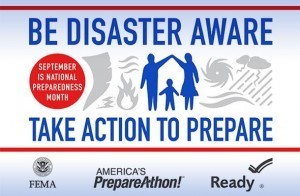
Visit www.ready.gov
Tornadoes, hurricanes, wildfires, floods. Perhaps you’ve lived through one or more of these natural disasters and lived to tell about it. Or maybe you’re one of those people at the other end of the spectrum who live in fear of something disastrous happening.
I think most of us would rather not think about the unthinkable. But thinking now – and more importantly, taking action now – could save your life and the lives of the people you care about most. At the very least, it could minimize the potential for injury or damage and help you get your life back on track faster.
September is National Preparedness Month and my goal in writing this article is to raise awareness about the importance of being prepared for emergencies. And I’m not just talking about being able to find a flashlight in the pitch dark if you lose power.
You’ve heard the saying: Expect the best, but prepare for the worst, right? Go to www.ready.gov to learn what to do in the event of a natural disaster. You’ll find links for making a plan and building a disaster kit, how to plan for disaster with kids and pets, and lots more.
I’d like to point out that if flooding is a possibility in your community, you’ll want to store things in watertight bins off the floor in your basement. If wildfires sometimes sweep through your area or surrounding communities, you should be prepared to evacuate your home on short notice. What is you only had 20 minutes? What would you take with you? The time to decide is now, not during an emergency situation.
Disaster or no disaster, it’s a good idea to keep organized records of important information and be sure to back up that information. You can scan and store important documents to a secure Cloud server, keep copies in a safe deposit box, or give copies to a trusted family member and do the same for them.
If you’re a newcomer to your area, check to see what natural disasters could happen there. I was surprised to learn when we moved to Michigan that tornadoes could be a threat. Of course, now more than ever, as full-time RVers, we need to stay tuned in to local news and weather forecasts wherever we go, especially in the Northwest where summer wildfires are common. At www.ready.gov, you can enter your zip code and get the low-down on disaster potential in your area.

That’s me doing a practice escape through an emergency exit.
Last month, I attended a rally of the Family Motor Coach Association, which included a seminar on fire safety. When the instructor asked for volunteers to do a practice escape through the emergency exit window of a motorhome, my hand shot up immediately. I was really nervous about crawling through the tiny bedroom window and allowing myself to fall to the ground. I’m sure that if there was a real fire, I would have managed to escape, but there’s a good chance I could have hurt myself in the process. Learning how to do it properly and having had that chance to practice doing it has given me the confidence to do it in an emergency (God forbid). And that’s one less thing I need to worry about.
What will you do to be better prepared for an emergency?
Got drugs?
Mark your calendar for September 27 – that’s National Prescription Take-Back Day. On this day, you can properly dispose of your unused and expired prescriptions by dropping them off at a local collection site between 10am and 2pm. To learn more and/or locate a site near you, click here.
If there is not a collection site near you, or if you need to dispose of medications at any time during the year, this is what is recommended:
Ask your local pharmacy if they collect expired prescriptions. If not, follow any disposal instructions on the label. Do not flush medicines down the sink or toilet unless this information instructs you to do so.
Remove medications from their original containers and mix them with an undesirable substance, such as used coffee grounds or kitty litter. This makes the drug less appealing to children and pets, and unrecognizable to people who go through trash seeking drugs. Place the mixture in a sealable bag, empty can, or other container to prevent the drug from leaking or breaking out of a garbage bag.
Before throwing out a medicine container, scratch out all identifying information on the prescription label to make it unreadable. This will help protect your identity and privacy.
Favorite organizing products and resources
As a professional organizer for the last 14 years, I’ve used and recommended a lot of organizing products, services and resources. Every month, in this column, I share my favorites.
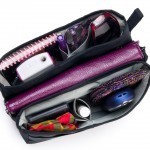
Purse Perfector
Last month, I re-introduced you to one of my all-time favorite organizing products. The Purse Perfector is an insert that transforms the inside of your purse from a black hole to a neatly organized interior. It comes in various colors and sizes to fit any purse – and makes it really easy to change purses. Just pull it out of one and pop it in another! The coupon code given last month has expired, but psssst…here’s a new one – USASEWS – to get the same 15% discount off the Purse Perfector.
This month, in keeping with the “be prepared” theme of this newsletter for National Preparedness Month, I’m going to suggest that you take a look at the Neat Desk scanner. If there was a fire, or a flood, or even just a power surge that fried your computer, would you still have your valuable files for your home or business? With a Neat Desk scanner, you can protect your tax documents, financial information and other valuable information. It scans up to 24 pages a minute so you can turn those piles of papers into organized digital files. Then use it continue to scan incoming receipts and other papers and never have to file paper again!
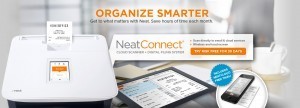
Neat Desk scanner
I used a Neat Desk scanner to scan tax documents, business bank statements and receipts, and my recipe collection when I made the decision to go paperless. It’s a super-fast and much easier alternative to scanning individual pages on your printer scanner (if you even have one). Plus it’s less expensive to buy the scanner and do it yourself vs. paying someone to scan all your documents. And oh, hey! I just popped over to their web site and guess what? You can get a Free Digital Filing System and NeatCloud Trial with the purchase of any scanner. Check it out!
For a look at more of my organizing favorites, including some new favorites, visit www.unclutter.com/suggestions
Looking for more cleaning, decluttering and organizing tips?
You’ll find more of my tips in these recenly published articles:
Clutter Clearing Tips from Organizing Experts (Family Circle)
10 Things You Can Clean in the Dishwasher (Womans Day)
The 10 Dirtiest Places in Your House (Better Homes & Gardens)
Shameless promotion: Better Homes and Gardens book
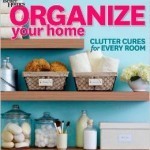 Last summer, Better Homes and Gardens released a book called Organize Your Home: Clutter Cures for Every Room. I was honored to be one of dozens of contributing professional organizers.
Last summer, Better Homes and Gardens released a book called Organize Your Home: Clutter Cures for Every Room. I was honored to be one of dozens of contributing professional organizers.
Why am I just telling you about it now, 15 months after the book’s launch? Well, I was cleaning out my email inbox today (yeah, I struggle with email too!) and found an email from the project manager with all of the launch information. Whoops! In my defense, it was being launched around the same time we sold our home and took off in our motorhome and I had a lot on my mind back then!
As the title suggests, it’s a comprehensive guide to getting and staying organized at home, room by room. Chapter by chapter, it walks you through the entire home, prividing key advice and inspiration to organize every space. Organize Your Home covers both sides of the organizing equation: the psychology of paring down possessions, reducing clutter, and staying organized as well as the nuts and bolts of finding the right bins, baskets, drawers, and more to store the items you do keep in attractive and efficient ways. Best of all, Organize Your Home shows you how real homes (with real budgets) make organization and efficiency a reality.
Anyway, I’m happy to report that this book has received excellent reviews. One reviewer wrote: I bought this to jump start some long overdue closet and pantry planning. I’ve ended up with some great ideas on how to increase efficiency all over my house. From bathroom cabinets to closets to pantries, this is a great resource for any of your organizing needs.
Organize Your Home is available from your favorite booksellers including Amazon. Happy organizing!
That’s all for this month. Until next month, keep it simple.
************************************************
FULL DISCLOSURE: Some links in this post may be affiliate links, meaning if you make a purchase through one of these links, I may earn a small commission which goes toward the continuation of this complimentary newsletter. Please note that I only recommend products that I would recommend whether I got paid or not.
The post Organizing Tips Newsletter – September 2014 appeared first on Declutter Your Life with Donna Smallin Kuper.
September 10, 2014
Prepping Your Home for [Blank]
![Prepping Your Home for [Blank] | Unclutter](https://i.gr-assets.com/images/S/compressed.photo.goodreads.com/hostedimages/1410473157i/11111810.jpg)
photo credit: bigarnex via photopin cc
Prepping. Is that the same as organizing? Well, no. But if you prep or prepare your home for something, you and your home will be more organized as a result.
You can prep your home for guests or for an upcoming holiday event at your home. You can prep it for a move, even if you have no immediate plans for a move. Or you can prep your home for the inevitable occasion when your family members will have to sort through your stuff after you’re gone. Horrible thought, I know, and one that most people don’t want think about.
I’ve witnessed numerous times where family members have had to deal with the belongings of their deceased loved ones. And I’ve often thought to myself, “I bet they didn’t want anyone to see that!” and “I’m sure they didn’t plan to leave behind such an overwhelming undertaking for their children.”
That’s why I’ve made sure that, if anything were to happen to me, my stuff won’t be too overwhelming for someone else to deal with, embarrassing in any way, or the kind of stuff that might cause trouble for someone else.
I rest easier knowing that my home is prepped – for all of the reasons above.
In keeping my home prepped for unexpected guests, I don’t have the stress of handling last-minute work to get the place ready. And, since my last move, I make sure that I have just what I need and not more than I need. I’m pretty sure there are no more garage sales in my future!
My advice to my clients – and to the people I love – is to keep your home prepped and ready for anything by dealing with your stuff now rather than later. And that requires routine prepping. Think of it as organizing for the future.
There are many places where stuff gets stashed or tossed or placed and forgotten about. It’s just a matter of looking and sorting through those places every once in awhile. It might mean going through a desk drawer on one day and the linen closet on another day and so on until the amount of stuff in your home feels right to you.
Imagine the feeling of peace I have knowing that at any minute a guest could show up at my door, or that I have to leave town unexpectedly and get a house sitter, or that my landlord is selling the property and I have to move quickly (which happened), or even if something dreadful happened to me.
Prepping your home – for anything – will give you the confidence that you are ready for anything, and that your stuff won’t be a burden to anyone, including (and especially) you.
Cyndi Seidler is an organization lifestylist, specializing in helping individuals put order into their space and their lives – and transforming spaces into areas that smile back at them. She has been providing organizing and room makeover services to homes and businesses for 20 years, and was dubbed “Organizer to the Stars” by the media. To her clients, she is The Organizing Lady. She serves the northeast and west valleys of Los Angeles. Visit her website www.organizinglady.com
The post Prepping Your Home for [Blank] appeared first on Declutter Your Life with Donna Smallin Kuper.
September 4, 2014
Easy Organizing Trick – Label Everything
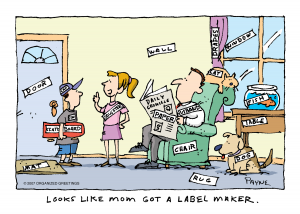
Courtesy OrganizedGreetings.com
If you want to organize your home and keep it organized (and I know you do), I have two words for you. Label everything.
Labeling is one of the simplest, yet most effective organizing tricks. Why? Because it creates a visual cue to put things where they belong. Start labeling and watch as things practically put themselves away!
There are other benefits of labeling as well.
Years ago, I rented a home that had a linen closet and in that linen closet, all the shelves were labeled: queen sheets – fitted, queen sheets – flat, pillowcases, etc. You might prefer to label by family member names.
Either way, family members won’t be able to get away with the old “But I don’t know where stuff goes” excuse when you ask for help putting away or retrieving clean linens.
Label shelves in your pantry and you’ll find it easier to maintain an organized pantry – and maybe get some help putting away groceries as well. Simply sort pantry items by type such as baking, cereals, snacks, canned goods, and grains. Create zones in your pantry for these categories and then label the shelves accordingly.
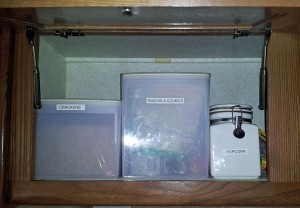 When I was a kid, I loved my Dymo Embossing Label Maker. Remember those? You can still get them! But my favorite labelmaker today is my Brother P-Touch Labeler, a very handy and inexpensive tool that I use often. In the photo at the left, you can see how I labeled some plastic bins in one of the pantry areas in our motorhome. (This way, if I ever start losing my mind, at least I can still find the snacks.)
When I was a kid, I loved my Dymo Embossing Label Maker. Remember those? You can still get them! But my favorite labelmaker today is my Brother P-Touch Labeler, a very handy and inexpensive tool that I use often. In the photo at the left, you can see how I labeled some plastic bins in one of the pantry areas in our motorhome. (This way, if I ever start losing my mind, at least I can still find the snacks.)
One of my dreaded tasks used to be creating file folder labels. I don’t know about you, but it seems that as soon as I label a file folder, I wish I had called it something different. Making matters worse, I also re-organize my filing system periodically to meet my ever-changing needs. (Yeah, I know. It’s a sickness…I’m an organizing addict.)
I finally committed awhile back to using just hanging files folders – not interior file folders. I was pretty psyched when I discovered a way to quickly and easily label my files with dry-erase tabs made specially for hanging files. I love, love, love Filertek Hanging File Dry-Erase Reusable Tabs and really wish I had invented them. They come with a dry-erase pen that you use to write on the plastic tab. If you want to change the label at any time, simply erase it. If you’re a perfectionist like me, these filing tabs might be just what you needed to finally set up a new filing system.
Of course, you can just use a black felt tip marker to label boxes or plastic bins and do the same to label folders. But I prefer to have a labeling system that is not so permanent.
Oh, the joys of labeling! Who knew a person could get so excited about labels?
At the annual conference of the National Association of Professional Organizers this past spring, I picked up a sample pack of identa-label Reusable Label Holders. These label holders stick to all sorts of materials including bins, baskets, boxes, and freezer containers and can be moved or even removed to another container. They come with paper label inserts for quick and easy labeling. Just grab a marker or pen. Or you can download their free printer templates. I am using them to label bins for holiday decorations, photos, and beach/pool stuff that we have stored in the “basement” of our motorhome.
If you’ve got kids, you’re going to love this idea – label their backpacks, lunch boxes, and anything else they are likely to lose. Label their clothing, too, especially jackets, hats and boots. With Mabel’s Labels, you can create personalized labels for just about anything. They even have labels that wash away for things like potluck dishes, leftover containers, and canning jars. Don’t forget to create a label for your eyeglass cases, umbrellas, and anything else that could get accidentally left behind.
Got any favorite stories about how labeling has saved you time – or saved the day? Do tell!
FULL DISCLOSURE: Some links in this post may be affiliate links, meaning if you make a purchase through one of these links, I may earn a small commission which goes toward the continuation of this blog and other free services I provide. Please note that I only recommend products that I would recommend whether I got paid or not.
The post Easy Organizing Trick – Label Everything appeared first on Declutter Your Life with Donna Smallin Kuper.
August 28, 2014
Organizing Tips Newsletter – August 2014
ORGANIZING PLAIN & SIMPLE MONTHLY
Tips & Inspiration for Organizing a Simpler Life
August 2014 – Vol. 13 No. 5
A man is rich in proportion to the number of things which he can afford to let alone. ~Henry David Thoreau
One year down the road

Our home at Lone Rock on Lake Powell, AZ circa April 2014
A year ago last month, my husband and I sold our home and most of what we owned to hit the road as full-time RVers. And we both agree that it was the best decision we’ve made as a couple – apart from getting married in the first place!
I’m not going to say it was easy to let go of a lifetime of accumulation. We had to keep reminding ourselves that we had a choice. We could either have our stuff or have the adventure of a lifetime. But we couldn’t have both.
In the first month, the only thing I missed was a pie plate that I must have inadvertently sold in our estate sale. Speaking of estate sales, when we settle down someday, I fully intend to furnish our new home with previously owned items like the ones we sold for a fraction of the cost of new.
While visiting our oldest daughter and her kids this summer, I unloaded a full set of pots and pans that we retired when we bought a new induction cooktop. I also gave them a large metal gourd that I thought I couldn’t live without (I was tired of stubbing my toe on it) and a leather purse that I wasn’t ready to part with a year ago for reasons unknown to me today.
Even after selling most of my stuff, I have everything I want and need. And my life is richer and more abundant than ever.
Downsizing forces you to figure out what’s really important to you. I still have my piano (a full, 88-key digital keyboard) that I enjoy playing and my bicycle (I’m in training for the 2015 Senior Olympics). I also love to cook. So I kept all of my favorite appliances, including a full-size Cuisinart food processor and my Vitamix. And I have small pieces of artwork I’ve collected over the years.
I am proud to say that we are now virtually paperless. I sent all of my receipts and other tax documentation to my Shoeboxed account where I can access them at any time and from anywhere. I use the Shoeboxed app to upload photos of receipts as I receive them, so I can just toss the paper. (By the way, I contacted my friends at Shoeboxed and they set up a special 50% offer for you to get your own Shoeboxed account! Just click here.)
It used to take me two full hours to clean just the main floor of my sticks-and-bricks home. Now I’m done cleaning so fast that I often think I must be forgetting something!
There’s a real freedom that comes from letting go. With less stuff to take care of and manage, I have more time to meet new people and explore new places. One of my most memorable experiences this year was riding my bicycle past buffalo on the side of the road in Yellowstone National Park and spending two glorious days off the grid on a friend’s property in Montana. (If you want to read more about our life on the road, please visit our blog at FlyingTheKoop.com.)
Many people tell us that we are living their dream. Ironically, it was never our dream to live and travel the country in a motorhome. But when my husband decided to take an early retirement, it was an option that we started exploring and it wasn’t long before we chose to take the leap. I recognize, of course, that living in a tiny home on wheels is not for everyone.
I wrote this post in hopes that our downsizing experience might inspire you to declutter your life to whatever degree feels right for you. If you were to do that, what might your life be like one year down the road?
(Footnote: I was interviewed recently for this podcast in which I share my story of selling our home and everything to become air-conditioned gypsies. Give a listen!)
Why didn’t I think of that? Reader tip…
I have a small white board on the refrigerator that I use for food inventory. When leftovers go in the fridge, I make a note of the date and the item (e.g. Sun, 07/6/14 chicken).
As items are used up, I cross them off the list. This way I know what leftovers we have without opening the refrigerator and the leftovers don’t get wasted because nobody remembered they were there.
After the board is full and all of the leftovers listed have been used up, then I erase the entire board and start all over again.
~Tonja Bender, Gwynn Oak, MD
Do YOU have a tip you’d like to share? Email donna@unclutter.com.
Favorite organizing products and resources
As a professional organizer for the last 14 years, I’ve used and recommended a lot of organizing products, services and resources. Every month, in this column, I share my favorites.

Enjoy unlimited access to your favorite magazines with the Next Issue app!
Last month, I introduced you to the Next Issue app that offers unlimited access to more than 140 of today’s best magazines – and all their back issues. Once you install Next Issue, you can read your favorite magazines on your tablet or computer – anytime, anywhere.
Three lucky winners were drawn at random to win a 3-month subscription of the Premium Account. Congratulations to Stepanie Hufton, Stephanie Kania, and Linda Walker! If none of those names is yours, you can still “win” by signing up for Next Issue’s 60-day free trial.

Finally! A perfectly organized purse.
This month, I want to re-introduce you to one of my all-time favorite organizing products. The Purse Perfector is an insert that transforms the inside of your purse from a black hole to a neatly organized interior. It comes in various colors and sizes to fit any purse – and makes it really easy to change purses. Just pull it out of one and pop it in another!
Company founder Lyn Marsteller, says, “I created the Purse Perfector as a labor of love as well as one of need. I wanted to be able to organize my handbags so that the items I carried would be easily found.” She’s offering the Purse Perfector for 15% off the list price through 9/5/14. Just use the coupon code USAMADE at checkout.
For a look at more of my organizing favorites, including some new favorites, visit www.unclutter.com/suggestions.
Shameless promotion: Making headlines
I just returned from a quick trip to New York City where I was invited to the Better Homes and Gardens studio to do six, 90-second video interviews on cleaning that will appear later this year on the magazine’s web site. That was fun! When the videos are published, I’ll be sure to let you know.
While in New York, I had the pleasure to meet with my favorite editor at Real Simple magazine as well as the magazine’s Home Director. We’ve worked on a number of stories this year including their August cover story on doing laundry. I also met with the Associate Lifestyles Editor at Parents magazine who was looking for some tips for an upcoming “get organized” story.
I generally spend a few hours each week responding to requests for cleaning and organizing tips from magazine editors and writers. I don’t get paid, but I enjoy being able to share what I know with hundreds of thousands of readers each month. Maybe that’s how you found my blog!
Here’s a timely article that was recently published on BobVila.com, featuring my garage organizing tips. I say “timely” because now is a good time to cross that organizing project off your to-do list before it gets too cold and snowy to get it done.
Finally, if you’ve been following me for awhile, you might be familiar with the first book I wrote – Unclutter Your Home in 7 Simple Steps. It’s actually out of print now, but over the summer, I spent a few weeks updating it and the updated version is being released next month as a Kindle book. I’ll get that link to you as soon as I get it!
That’s all for this month. Until next month, keep it simple.
************************************************
FULL DISCLOSURE: Some links in this post may be affiliate links, meaning if you make a purchase through one of these links, I may earn a small commission which goes toward the continuation of this complimentary newsletter. Please note that I only recommend products that I would recommend whether I got paid or not.
The post Organizing Tips Newsletter – August 2014 appeared first on Declutter Your Life with Donna Smallin Kuper.
July 31, 2014
7 Rs of Eco-Organizing

photo credit: otherthings via photopin
I asked professional eco-organizer, Julie Coraccio, to share some easy tips to help you go green when letting go of clutter while also preventing clutter from building. Every little thing you do can make a big difference. Here are Julie’s 7 Rs of eco-organizing.
1. Reduce: Donate items that you no longer love, need, or use to those who could put those items to good use right now. Pick a charity or adopt a family to give things to. What’s in it for you? The less stuff you have, the less you have to organize.
2. Re-use: It’s great if you save things like shipping boxes for re-use, but if you don’t have an immediate or forseeable need for them when you empty them, pass them along. Take them to a local moving company, to BJ’s or Sam’s, or find out if a business or nonprofit organization is moving and give the boxes to them.
3. Repair: Attempt to repair an item before purchasing another one or throwing it out. There are lots of handy people out there! If you can’t repair it yourself, look for someone who can. Ask around.
4. Re-purpose: Figure out how you might be able to re-purpose an item. Get creative. Instead of buying a special plastic case for holiday ornaments, I use a cardboard wine case with dividers. And you know those clear plastic, zippered bags that new bedding and curtains come in? I use them to store holiday lights and electrical cords.
5. Return: Are you holding on to things that belong to someone else – like things your grown children left behind? You aren’t required to hold on to what doesn’t belong to you. Return that stuff and get your space back! (If they don’t want it, then go ahead and donate it.)
6. Recycle: Set up a recycling center in your home or business to make it easy to recycle things like plastic bottles, metal cans, dry cleaner hangers, plastic grocery bags, paper/cardboard. Know your community’s guidelines and learn what you can take where for recycling. Then please do your part.
7. Re-think: Think before you buy. Then think again. Do you really need that item? Do you really love it? Modern conveniences and marketers have convinced us that we need stuff we really don’t! More stuff will not bring you happiness or joy. Consider purchasing experiences versus things.
Some of my favorite eco-organizing resources
Don’t want to hold on to that thick manual? It’s probably here: www.manualsonline.com
Learn how to live a greener lifestyle and get rewarded for it: https://www.recyclebank.com
Need a pair of skis for a weekend trip or an entertainment system for a party? Rent it at at http://us.zilok.com
Stop junk mail: http://www.41pounds.org and https://www.dmachoice.org
Good choices for reducing: http://www.freecycle.org and http://giveyourstuffaway.com
Recycling electronics: http://www.econewonline.com and http://www.greendisk.com/
My husband served in the Army and I am a fan of this pick-up charity: http://www.scheduleapickup.com
You’ll find lots more on my site: http://www.healingorganization.com
Reduce paper clutter with these handy apps
Love, love, love Paper Karma app for stopping junk mail before it starts! And it’s free.
Use Evernote to save your ideas, things you see, and things you like. Then find them all on any computer or device you use – also free.
Notability: Use to test out furniture placement in your home.
Notespark: Share to-do lists with family, friends, colleagues. When you cross something off the list, it’s deleted from the synchronized list.
Genius Scan+: Great if you have lots of receipts to manage.
 Julie Coraccio is a professional organizer and coach. She was the first professional organizer in North Carolina to specialize in green organization for both home and business. In 2011, she was awarded the NAPO-LA Green Award for Most Eco-Friendly Organizing Service and the Triangle Business Journal’s Green Entrepreneurial Effort/Innovative Idea of the Year Honorable Mention. She hosts the internet TV/podcast series, Clearing the Clutter Inside & Out. For more information about Julie, her services, and her show, please visit http://reawakenyourbrilliance.com and http://www.healingorganization.com
Julie Coraccio is a professional organizer and coach. She was the first professional organizer in North Carolina to specialize in green organization for both home and business. In 2011, she was awarded the NAPO-LA Green Award for Most Eco-Friendly Organizing Service and the Triangle Business Journal’s Green Entrepreneurial Effort/Innovative Idea of the Year Honorable Mention. She hosts the internet TV/podcast series, Clearing the Clutter Inside & Out. For more information about Julie, her services, and her show, please visit http://reawakenyourbrilliance.com and http://www.healingorganization.com
The post 7 Rs of Eco-Organizing appeared first on Declutter Your Life with Donna Smallin Kuper.
July 25, 2014
Organizing Tips Newsletter – July 2014
ORGANIZING PLAIN & SIMPLE MONTHLY
Tips & Inspiration for Organizing a Simpler Life
July 2014 – Vol. 13 No. 4
“The will to conquer is the first condition of victory.” ~ Ferdinand Foch

photo credit: Tracy O via photopin cc
5 ways to save money every month by getting organized
You have your reasons for getting organized, I’m sure. Is “saving money” one of them? If you could use a little extra cash in your pocket – whether it’s for back-to-school necessities or a much-needed weekend getaway – here are five simple ways you can save money by getting organized.
1. Create a bill-paying system. Do you tend to misplace bills? If you pay bills late, you get hit with late fees. Plus, if your credit card payment is late, the lender may decide to raise your interest rate to 25% or more which will cost you even more money for months and years to come.
Simple fix: As bills arrive, place them in a large envelope or folder marked “Bills to Pay”and keep it where you store your checkbook. Create a reminder in your calendar to pay that bill before the due date or schedule a “Bill Pay Day” twice a month for paying all of your bills for that two-week period.
I’ve opted to receive paperless statements. What I do is forward the email message about the due date to my FollowUpThen.com account. With FollowUpThen, you can schedule that email to be re-sent to you next week, on the due date, your next pay day, or whenever you plan to pay the bill.
2. Take advantage of discounts and deals. There are certain times of the year when it’s best to buy certain items. Example: You’ll find great deals on holiday wrapping paper immediately after the holidays. And the best time to buy a car is in September when you can get the current year model for a great price because dealers want to clear inventory to make room for the new year models.
Here’s a great post on the best time of year to buy just about anything that I highly recommend reading and bookmarking. Plan your purchases accordingly and you can save hundreds of dollars – or more – every year.
Also, pay close attention to early-bird registration deadlines and be sure to act sooner rather than later so you don’t pay more than necessary. I recently learned that the best time to buy an airline ticket is 54 days before take-off to get the best price. You might also try Fly.com’s fare calendar for helping you find the best fare in the next 90 days.
3. Sort and straighten regularly. A lot of people end up re-buying things they can’t find only to find the original stuff later. Example: If your closet is disorganized, you might end up buying clothes or shoes that are similar to ones you already have. It happens, right? I once met a woman who could not find her Christmas decorations so she bought all new decorations and when she went to put them away, she found all of her old decorations.
Make it habit to do a little straightening up every month or at least every quarter. Use the start of each new month or season as your queue to get to it! Better yet, do a little straightening up every day and get your home organized drawer by drawer, closet by closet, room by room.
4. Organize your pantry. When I got married, I noticed that my husband would just put things back anywhere in the pantry. He didn’t realized that I had set up zones for snacks, cereals, pastas and grains, canned vegetables, etc. Set up zones for keeping “like with like.” If you label the shelves, it makes it even easier for everyone to find and return items.
I also make a note immediately when I use up an item or see that I am running low on something. I use the Out of Milk app on my phone to keep a running grocery list. I have everything organized by area of the store such as dairy, bread, vegetables and fruits, meat, etc.
Bottom line: When you have a well-stocked pantry, you’re more likely to have what you need to make simple, healthy meals instead of ordering take-out or going out for meals, which can quickly add up to a small fortune.
5. Sell or donate what you aren’t using. Turn your clutter into cash! The average American home contains thousands of dollars worth of stuff just sitting around that can be sold – or donated for the tax write-off. I wrote an entire book about doing just that. It’s called How to Declutter and Make Money Now and it includes tips for organizing a successful garage sale, selling on Craigslist, and the best online sites for selling your old cell phone, books, clothing, and more. Save your earnings for a rainy day or put it toward something you need.
By the way, Amazon just introduced the Kindle Unlimited program. For just $9.99 a month, you get unlimited access to 600,000 Kindle books, including all of mine. Another way to save! Learn more about the Kindle Unlimited program on the Amazon page for my book, How to Declutter and Make Money Now.
Can you think of other ways that you can save money by getting organized? Leave a comment below!
Why didn’t I think of that? Reader tip…
I have a chalk board in my kitchen and about six weeks ago, I decided to track stuff coming and going to make sure it was going. So every time something was brought into the house, I added one to the number on the chalk board. And every time some thing left, I subtracted one (not counting food or similar consumables).
For example, when I got a new set of sheets, the tally was +4 minus 1 for one old sheet tossed = 3. I told myself I would reward myself with a nice dinner out when I reached -100. I was actually surprised at how the number kept climbing for about three weeks. It actually got to +28. Then I donated a bag of stuff to an auction and it went down to +8.
Today it’s at +10 but I find myself at the store looking at something and thinking, “Is this really worth making my number on the chalk board go up?” So it’s working for me! ~ Susan Kelley, Kent, WA
Do YOU have a tip you’d like to share? Email donna@unclutter.com.
Favorite organizing products and resources
As a professional organizer for the last 14 years, I’ve used and recommended a lot of organizing products, services and resources. Every month, in this column, I share my favorites.
Last month, I introduced you to FotoBridge, the company I’ve chosen to scan all of my photographs. I met them at the annual conference of the National Association of Professional Organizers back in May and was impressed with their commitment to fast, safe and secure scanning services for their customers – and they guarantee 100% satisfaction. You send your photos, slides, negatives, even video and they will transform them into digital memories on DVD. My new friends at FotoBridge have kindly offered a 10% discount that you can apply to your order should you decided to try this service. Enter the coupon code “Unclutter” without the quotation marks at checkout. (See Organizing Tips Newsletter – June 2014 for tips on how to organize your photos manually and digitally.)
 This month, I want to share something for magazine lovers. The Next Issue app offers unlimited access to more than 130 of today’s best magazines – and all their back issues – in full color. The experience is not only beautiful, but interactive at the same time. What that means is (are you ready for this?) you can do things like email articles and save recipes. Oh, my gosh. That’s what sold me. Plus you get access to digital-only features available through some magazines, including downloadable playlists, embedded videos and extended photo slideshows.
This month, I want to share something for magazine lovers. The Next Issue app offers unlimited access to more than 130 of today’s best magazines – and all their back issues – in full color. The experience is not only beautiful, but interactive at the same time. What that means is (are you ready for this?) you can do things like email articles and save recipes. Oh, my gosh. That’s what sold me. Plus you get access to digital-only features available through some magazines, including downloadable playlists, embedded videos and extended photo slideshows.
Once you install Next Issue, you can read your favorite magazines on your tablet or computer – anytime, anywhere. It’s a great way to get rid of magazine clutter and yet, always have reading material handy. It costs $9.99 a month, which works out to be about the same as picking up two issues at the supermarket, airport or drugstore over the course of a month (or $14.99 a month if you want access to weekly publications like People as well as monthly publications.) If you and your family members currently pay for more than a few subscriptions, you’ll actually save money every month because with one account, everyone in your family can access their favorite magazines (on up to 4 devices). Plus you can cancel your printed subscriptions and request a refund for the unused portion of your subscription.
The folks at Next Issue set me up with a 3-month subscription of their Premium Account. I asked them if I could do something for my readers and they authorized me to give away three Premium Account subscriptions just like mine! So I set up a giveaway where you can enter to win one of three 3-month subscriptions to Next Issue. a Rafflecopter giveawayGood luck and stay tuned for a list of winners! Meanwhile, you might want to take advantage of Next Issue’s 60-day free trial.
For a look at more of my organizing favorites, including some new favorites, visit www.unclutter.com/suggestions.
Shameless promotion: Looking for speaking gigs – and scouts!

photo credit: Håkan Dahlström via photopin cc
I have a new book coming out in November called Clear the Clutter, Find Happiness (Storey Publishing) and I’ll be touring the country in 2015 to promote it via book signings, television appearances, and Clear the Clutter, Find Happiness seminars.
Do you belong to an organization in need of speakers? Let’s talk! I’m also looking for scouts who may know of locations where we could hold a decluttering seminar. Ideas? Questions? Email donna@unclutter.com.
Our current travel plans for 2015 include Phoenix (January-March), Texas-Louisiana-Alabama-Tennesee (April-June), Minnesota (late June-early July), Michigan (July), New York State (August), and then south along the eastern seaboard to Florida for the winter.
That’s all for this month. Until next month, keep it simple.
************************************************
FULL DISCLOSURE: Some links in this post may be affiliate links, meaning if you make a purchase through one of these links, I may earn a small commission which goes toward the continuation of this complimentary newsletter. Please note that I only recommend products that I would recommend whether I got paid or not.
The post Organizing Tips Newsletter – July 2014 appeared first on Declutter Your Life with Donna Smallin Kuper.
July 18, 2014
Decluttering and the Broken Windows Theory
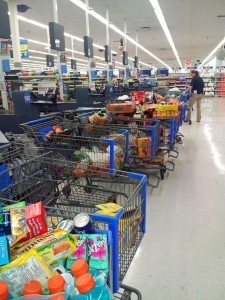 Bright and early one morning, I went into a Super WalMart store and was greeted by dozens of shopping carts filled with all kinds of stuff. The carts lined the entire front end of the store and workers were busy moving items from one cart to another.
Bright and early one morning, I went into a Super WalMart store and was greeted by dozens of shopping carts filled with all kinds of stuff. The carts lined the entire front end of the store and workers were busy moving items from one cart to another.
I wondered what was going on so I approached one of the workers and asked, “What’s up with all these carts?”
She said, “They’re returns.”
Every day, WalMart employees take to the aisles of the store with carts to collect items that were picked up in one place and put down somewhere else. All of these items must be sorted and returned to where they belong.
It reminded me of the broken windows theory.
If you’re not familiar with this theory, here’s a quick excerpt from Wikipedia about it:
The broken windows theory was first introduced by social scientists James Q. Wilson and George L. Kelling, in an article titled “Broken Windows” which appeared in the March 1982 edition of The Atlantic Monthly. The title comes from the following example:
Consider a building with a few broken windows. If the windows are not repaired, the tendency is for vandals to break a few more windows. Eventually, they may even break into the building, and if it’s unoccupied, perhaps become squatters or light fires inside.
Or consider a pavement. Some litter accumulates. Soon, more litter accumulates. Eventually, people even start leaving bags of refuse from take-out restaurants there or even break into cars.
I think that’s what happens in stores – shoppers just put down unwanted items anywhere rather than returning them to where they belong. Maybe they (we!) figure it’s someone else’s job to pick up after us.
But what happens when we don’t return things to where they belong at home?
You know what happens!
One thing leads to another until we have a pile of stuff to put away. And when we routinely don’t pick up after ourselves, we create what’s called a norm which, in essence, gives social permission for everyone else in our home to do the same.
Are you in the habit of “returning” things to the nearest empty space?
Next time you start to put something down, ask yourself: Is this where it belongs? If not, stop what you’re doing and go put it away. It’s easy to do and will only take a few moments.
Then watch what happens over time. This one simple change of behavior will go a long way toward decluttering your home, plus save you time, effort, and stress.
Repeat after me: Don’t just put it down, put it away.
The post Decluttering and the Broken Windows Theory appeared first on Declutter Your Life with Donna Smallin Kuper.
July 10, 2014
Paper Piles and Delayed Decision Disorder (DDD)
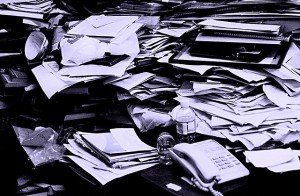
photo credit: Kris Krug via photopin cc
As a professional organizer, I work with a lot of clients who struggle with anxiety and a sense of heaviness related to piles of paper. They often feel overwhelmed, frustrated, and out of control.
Through the years of purging piles and clearing clutter with my clients, it has become very clear to me that the root cause of this issue is what I have coined as Delayed Decision Disorder (DDD). DDD is not a valid medical term, but it is the root cause of every pile of paper, every piece of unprocessed mail, every cluttered closet, and every folder or bin of “miscellaneous”stuff.
So how do you get DDD and, more importantly, how do you cure it?
Often piles start with the inner conversation that says, “Oh, I’ll just do this later,” or “I’m too busy right now” or we simply get side-tracked and turn our focus elsewhere. Understand this, DDD is not the occasional procrastination that we all fall victim to from time to time. It is the continual delaying of decisions and half-finished projects accumulating over extended periods of time. What happens with delayed decisions as it relates to paper is the creation of a “piling system” when what we really long for is an efficient “filing system.”
So, are you afflicted with DDD?
Symptoms: Paper piles, cluttered countertops and flat surfaces, unprocessed bills, unfiled receipts, junk mail, newspapers, magazines, business cards, school work, bulging filing cabinets, expired coupons, manuals and warranties for things you no longer own
Causes: Procrastination, loss of focus, inadequate or non-existent systems, uncompleted tasks, not knowing what to keep and what to toss out, not having proper supplies or adequate space
Remedies: Physical therapy (as in sorting, purging, MAKING decisions, and filing) and a commitment to stick with the project through completion
Possible side effects: Reclaimed time previously wasted looking for lost items, uncluttered flat surfaces, money saved by eliminating late fees and penalties, increased peace of mind knowing right where things are, feeling empowered and more in control
“Sometimes you don’t feel the weight of something you’ve been carrying until you feel the weight of its release.”
~Joshua Becker
5 Tips for Reducing Paper Clutter
1. Discard unwanted mail and paper before it enters your home or office.
2. Remove yourself from junk mail lists and cancel subscriptions to magazines and catalogs that you do not read. Contact originators to be removed from lists.
3. Create an inbox or tray for papers that need to be processed.
4. Create four file folders and label them: To Do, To File, To Read, To Others. Optional folders: To Scan, To Shred. Keep file folders in plain sight for easy access; I recommend a vertical desktop file folder sorter for this purpose.
5. In a timely manner, separate paper into the four or six categories listed in #4 and then process them according to the associated task.
In summary, getting organized and clearing piles and clutter requires a commitment to go through the process that takes you from chaos to calm. That process includes: Making timely decisions, setting up systems to process paperwork effectively, eliminating the unnecessary, and committing the time necessary to clear and then maintain paperwork, and becoming very intentional about what you bring into your home or office.
©2014 Simple Organized Solutions
 Andrea Brundage is a professional organizer/productivity consultant and a public speaker. Her company, Simple Organized Solutions, educates and consults with clients who are tired of the overwhelm and want to live in an intentional and organized environment. To connect with Andrea, visit www.ProfessionalOrganizerAZ.com, www.twitter.com/andrea_brundage, www.facebook.com/ProfessionalOrganizerAZ or call (480) 382-1085.
Andrea Brundage is a professional organizer/productivity consultant and a public speaker. Her company, Simple Organized Solutions, educates and consults with clients who are tired of the overwhelm and want to live in an intentional and organized environment. To connect with Andrea, visit www.ProfessionalOrganizerAZ.com, www.twitter.com/andrea_brundage, www.facebook.com/ProfessionalOrganizerAZ or call (480) 382-1085.
The post Paper Piles and Delayed Decision Disorder (DDD) appeared first on Declutter Your Life with Donna Smallin Kuper.
The One-Minute Organizer Blog
- Donna Smallin Kuper's profile
- 45 followers


![Prepping Your Home for [Blank] | Unclutter](https://i.gr-assets.com/images/S/compressed.photo.goodreads.com/hostedimages/1410473157i/11111811.png)

